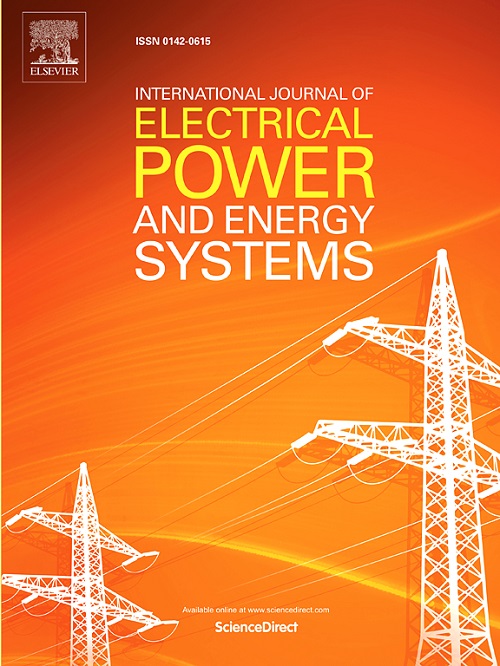Optimized multi-unit coordinated scheduling based on improved IGDT: Low-carbon scheduling research for the electric-heat-oxygen integrated energy system
IF 5
2区 工程技术
Q1 ENGINEERING, ELECTRICAL & ELECTRONIC
International Journal of Electrical Power & Energy Systems
Pub Date : 2025-03-25
DOI:10.1016/j.ijepes.2025.110629
引用次数: 0
Abstract
To address the oxygen supply demands and the challenges posed by high penetration of renewable energy in high-altitude regions, this paper proposes a low-carbon scheduling model for an electric-heat-oxygen integrated energy system (EHO-IES), designed for energy dispatch and management in these areas. The model integrates carbon capture and storage with power-to-gas (CCS-P2G), concentrated solar power plant (CSPP), combined heat and power (CHP) unit, and ground-source heat pump (GSHP). By optimizing the coordinated operation of multiple energy sources, the model enhances their complementarity and interaction. To effectively manage the multiple uncertainties in renewable energy and load, this study introduces an improved information-gap decision theory (IGDT) model, referred to as EWNS-IGDT. This model combines the entropy weight method (EWM) and non-dominated sorting genetic algorithm II (NSGA-II), improving the objectivity and rationality of uncertainty weight settings in risk-averse strategy (RAS) and risk-seeking strategy (RSS). The paper further analyzes the impact of these strategies on low-carbon scheduling. Case study results show that the coordinated operation of multiple units significantly reduces total cost (by 89.93 %) and carbon trading cost (by 97.95 %), while achieving near-complete integration of photovoltaic (PV) and wind turbine (WT) output. Under the RAS, total cost increased by 20 %, and carbon trading cost rose by 90.06 %. In contrast, under the RSS, total cost decreased by 19.98 %, while carbon trading cost significantly dropped by 321.90 %.
基于改进IGDT的多机组协同调度优化:电-热-氧一体化能源系统低碳调度研究
针对高海拔地区的供氧需求和可再生能源高渗透率带来的挑战,提出了一种针对高海拔地区能源调度与管理的电-热-氧一体化能源系统(EHO-IES)低碳调度模型。该模型将碳捕获和储存与电力制气(CCS-P2G)、聚光太阳能发电厂(CSPP)、热电联产(CHP)装置和地源热泵(GSHP)相结合。该模型通过优化多种能源的协同运行,增强了多种能源的互补性和交互性。为了有效管理可再生能源和负荷中的多重不确定性,本研究引入了一种改进的信息缺口决策理论(information-gap decision theory, IGDT)模型,简称EWNS-IGDT。该模型结合了熵权法(EWM)和非支配排序遗传算法II (NSGA-II),提高了风险规避策略(RAS)和风险寻求策略(RSS)中不确定性权重设置的客观性和合理性。本文进一步分析了这些策略对低碳调度的影响。案例研究结果表明,多机组协同运行显著降低了总成本(89.93%)和碳交易成本(97.95%),同时实现了光伏(PV)和风力发电(WT)的近乎完全整合。在RAS下,总成本增加了20%,碳交易成本增加了90.06%。相比之下,在RSS下,总成本下降了19.98%,而碳交易成本则显著下降了321.90%。
本文章由计算机程序翻译,如有差异,请以英文原文为准。
求助全文
约1分钟内获得全文
求助全文
来源期刊
CiteScore
12.10
自引率
17.30%
发文量
1022
审稿时长
51 days
期刊介绍:
The journal covers theoretical developments in electrical power and energy systems and their applications. The coverage embraces: generation and network planning; reliability; long and short term operation; expert systems; neural networks; object oriented systems; system control centres; database and information systems; stock and parameter estimation; system security and adequacy; network theory, modelling and computation; small and large system dynamics; dynamic model identification; on-line control including load and switching control; protection; distribution systems; energy economics; impact of non-conventional systems; and man-machine interfaces.
As well as original research papers, the journal publishes short contributions, book reviews and conference reports. All papers are peer-reviewed by at least two referees.

 求助内容:
求助内容: 应助结果提醒方式:
应助结果提醒方式:


